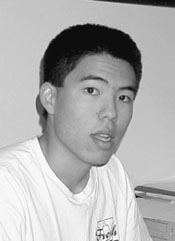Undergrad discovers novel atomic cluster

This September, Kevin Chan ’04 will have an interesting answer to the essay question, “What did you do on your summer vacation?” While working on a summer project at the San Diego Supercomputer Center (SDSC), 18-year-old Chan used one of the center’s supercomputers to discover a novel arrangement of atoms that had been missed by other scientists studying such clusters. Chan made the unexpected discovery in late June. He used a variation of a well-known mathematical technique to discover that 78 neutral atoms can theoretically settle into the shape of a particular “double icosahedron.” Icosahedrons – whether clusters of atoms or baseballs glued together – are 20-sided objects.
The structure Chan discovered looks like a Siamese twin of two 55-atom icosahedrons, with a few atoms missing. “I enjoy studying concepts such as symmetry in mathematics,” said Chan, “but I’m also fascinated with concrete examples of them. I find that very interesting.”
Chan, who is majoring in mathematics, made the discovery while working under the direction of Robert Leary, a SDSC applied mathematician. Leary has described Chan’s cluster in talks this summer at SDSC at the University of California, San Diego. The results have been electronically published in The Cambridge Cluster Database, and Leary and Chan also are planning to submit the results to a scientific journal.
Chan used a variant of a so-called “basin-hopping” algorithm developed by Leary. The mathematician and his colleagues try to understand how 10 to more than 100 neutral atoms arrange themselves into clusters with the lowest-energy states possible. The technique works like an explorer scanning new countryside. The algorithm “hops” from one possible energetic state to another, each of which correspond to a different cluster geometry, looking for the one with the deepest valley.
“Kevin’s result is really quite surprising when you consider the considerable attention given to this problem in previous computational studies,” said Leary.




